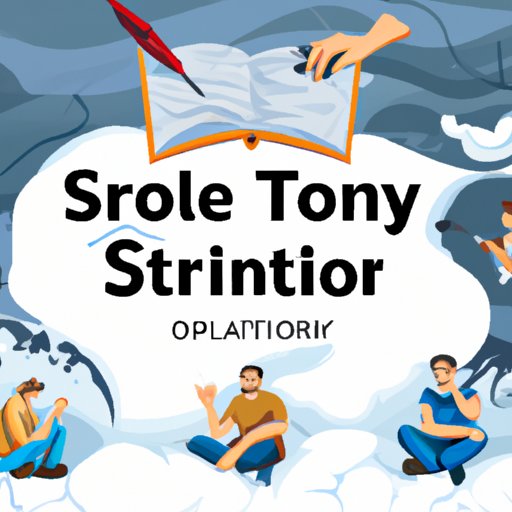Introduction
Story writing is an art form that requires skill, knowledge, and creativity. It’s a craft that can be learned by anyone willing to put in the effort and time to hone their skills. This article aims to provide a comprehensive guide on how to begin story writing. We will cover topics such as brainstorming plot ideas, creating interesting characters, developing a compelling setting, incorporating powerful emotions, and utilizing storytelling techniques.
Brainstorm Plot Ideas
The first step to story writing is to come up with a good plot. This requires research and careful consideration. Before you start writing, it’s important to do some research about your topic. Read books, watch movies, and pay attention to the news for inspiration. After gathering some ideas, create a brainstorming board to organize your thoughts. You can use sticky notes, a whiteboard, or even just a piece of paper. Write down all your ideas and then arrange them into different categories.
Once you have a general idea of the plot, it’s time to develop multiple plots. Think of different ways the story could unfold. Imagine different paths the protagonist could take and how the antagonist could react. The more options you have, the easier it will be to choose the best one. Don’t be afraid to get creative and think outside the box.
Start with an Interesting Character
Strong characters are essential to any story. To make your character stand out, you need to establish their personality. Give your character traits like ambition, loyalty, or arrogance. Introduce their goals and motivations. Show why they are driven to accomplish what they set out to do. Make sure to give your character flaws and fears as well. This will help make them more relatable to readers.
One thing to keep in mind is that your character’s actions should be consistent with their personality. Make sure their decisions feel natural and believable. If your character does something out of character, there should be a logical reason for it.
Create a Compelling Setting
A great story needs a great setting. Choose a location for your story and describe it in detail. Let your readers see, smell, and feel the environment. Use metaphors and similes to paint a vivid picture of the surroundings. Think about how the setting affects the characters and their actions. Does the setting inspire them or limit their choices? How do they react to their environment? These are all questions you should consider when crafting your setting.
Incorporate Powerful Emotions
Emotions play a huge role in stories. To make your story more engaging, explore your own emotions and tap into those of your characters. Conflict is an effective way to create tension and evoke powerful emotions. Show how the characters react to their struggles and how they handle adversity. Connect with your readers by making them feel what your characters are feeling.
Utilize Storytelling Techniques
To grab the reader’s attention, start your story with a strong hook. Hooks can be anything from a cliffhanger to an intriguing question. Foreshadowing is another effective storytelling technique. Plant hints throughout your story to build suspense and anticipation. Finally, make use of dramatic irony. This is when the reader knows something that the characters don’t. This creates a sense of anticipation and keeps the reader guessing.
Conclusion
Story writing is a complex art form that requires practice and dedication. This article has provided a step-by-step guide on how to begin story writing. We discussed topics such as brainstorming plot ideas, creating interesting characters, developing a compelling setting, incorporating powerful emotions, and utilizing storytelling techniques.
(Note: Is this article not meeting your expectations? Do you have knowledge or insights to share? Unlock new opportunities and expand your reach by joining our authors team. Click Registration to join us and share your expertise with our readers.)
